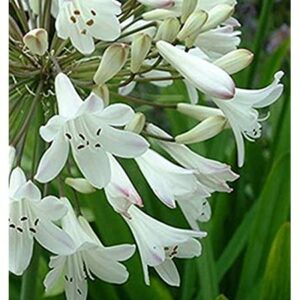Description
GardenAdvice Notes
Gaura lindheimeri, also known as Lindheimer’s beeblossom, is a perennial flowering plant that is native to Texas and Louisiana in the United States. It is a member of the evening primrose family (Onagraceae) and is valued for its delicate, butterfly-like flowers that bloom in late spring and early summer.
Gaura lindheimeri typically grows to a height of 2-4 feet (60-120 cm) and has a clumping, bushy growth habit. The leaves are narrow and lance-shaped, and are typically green or variegated with white. The flowers are borne on tall, wiry stems and are typically white or pink, with four petals that are arranged in a cross shape.
Gaura lindheimeri is a popular ornamental plant that is grown in gardens and landscapes for its attractive foliage and showy blooms. It is also a popular plant for attracting pollinators such as bees and butterflies.
Soil type-Gaura lindheimeri prefers well-draining soil that is moist but not waterlogged. It can tolerate a wide range of soil types, including sandy, loamy, and clay soils, as long as they are well-draining. However, it is best to avoid heavy, poorly-drained soils that can cause root rot and other issues. If your soil is heavy or poorly-draining, you can improve its drainage by amending it with organic matter such as compost, well-rotted manure, or peat moss. Additionally, Gaura lindheimeri prefers a soil pH that is neutral to slightly alkaline, between 6.0 and 7.5.
Location-Gaura lindheimeri grows best in locations with full sun exposure, although it can also tolerate some light shade. It is native to the southern United States and thrives in warm, humid climates with long, hot summers. However, it can also tolerate cooler temperatures and is hardy to USDA zones 5-9. In general, Gaura lindheimeri prefers well-ventilated locations with good air circulation to prevent the development of fungal diseases. It is well-suited for growing in borders, rock gardens, meadows, and other sunny, well-drained areas of the landscape.
Pest and disease problems-Gaura lindheimeri is generally considered to be a low-maintenance plant with few pest and disease problems. However, like all plants, it can be susceptible to certain issues under certain conditions. Some common pests that may affect Gaura lindheimeri include aphids, spider mites, and whiteflies. These pests can cause stunted growth, yellowing leaves, and other damage. Controlling these pests can typically be achieved through the use of insecticidal soaps, horticultural oils, or other organic pest control methods.
As for diseases, Gaura lindheimeri is generally considered to be relatively disease-resistant. However, it can be susceptible to fungal diseases such as powdery mildew and rust in humid conditions or if it is planted in poorly-drained soil. Powdery mildew can cause a white, powdery coating on the leaves and stems, while rust can cause orange or brown spots on the leaves. To prevent fungal diseases, it’s important to provide good air circulation around the plant, avoid overhead watering, and remove any infected plant material promptly. In some cases, fungicides may be necessary to control severe infections.
Propagation-Gaura lindheimeri can be propagated by seed or by division.
Propagation by seed is relatively straightforward. Seeds can be sown indoors in late winter or early spring, or directly outdoors in late spring or early summer. Seeds should be sown thinly in a seed-starting mix and covered lightly with soil. Keep the soil moist and warm, and seedlings should emerge in 1-2 weeks. Once the seedlings are large enough to handle, they can be transplanted into individual pots or planted outdoors in their final location.
Propagation by division is typically done in the fall, after the plant has finished flowering. To divide Gaura lindheimeri, dig up the plant and use a sharp knife or garden spade to divide the root ball into several smaller clumps. Each clump should have several stems and a healthy root system. Replant the divisions in their new location, spacing them out according to their mature size. Water well after planting, and keep the soil moist until the plants become established.
Pruning, cutting back and dividing-Gaura lindheimeri generally requires minimal pruning and cutting back. However, it can benefit from some light pruning in the early spring to remove any dead or damaged wood and encourage bushier growth. You can also deadhead the spent flowers throughout the growing season to promote continued blooming.
Dividing Gaura lindheimeri is typically done in the fall, after the plant has finished flowering. To divide the plant, dig it up and use a sharp knife or garden spade to divide the root ball into several smaller clumps. Each clump should have several stems and a healthy root system. Replant the divisions in their new location, spacing them out according to their mature size. Water well after planting, and keep the soil moist until the plants become established.
If your Gaura lindheimeri plant is getting too large or spreading too aggressively, you can also cut it back in the fall or early spring to control its size. Simply use sharp shears or pruners to cut back the stems to the desired size, taking care not to remove too much foliage at once. This will encourage bushier growth and help keep the plant within bounds.
Please note our plants in most instances are delivered by our own GardenAdvice expert gardeners. Our standard UK delivery charge is £25 or if you are a MyGardenTeam member delivery is free
Our plants are guaranteed for 24 months for more details Click Here
























Reviews
There are no reviews yet.